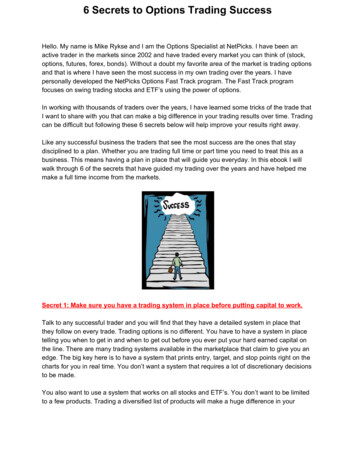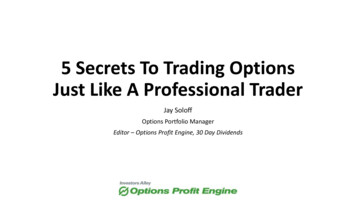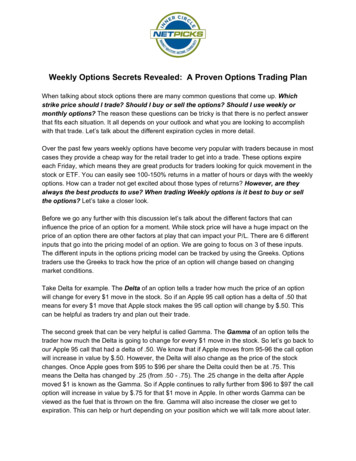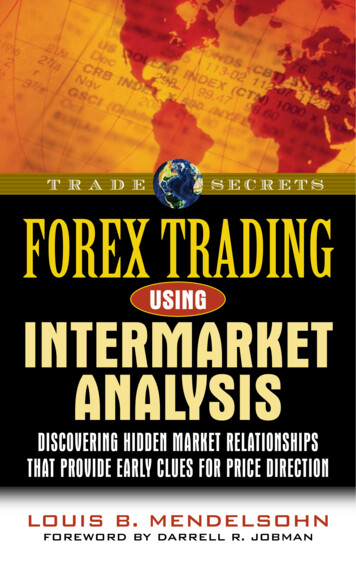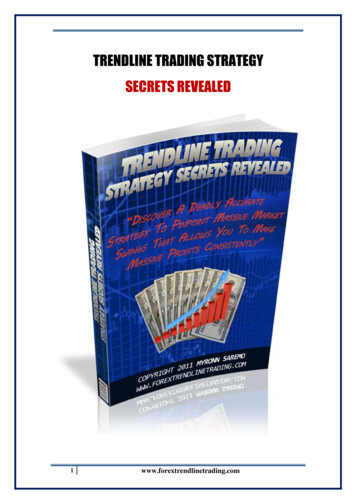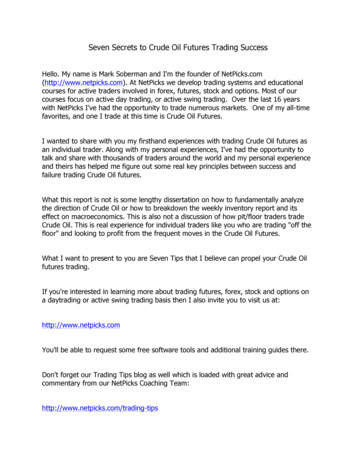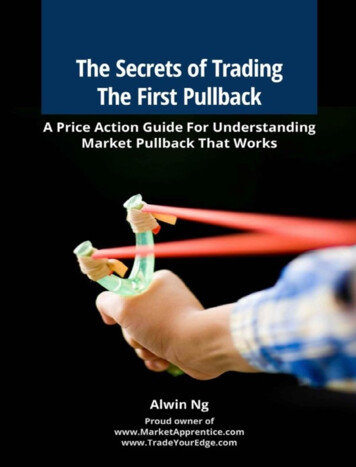
Transcription
Content1PREFACE2INTRODUCTION3GLOSSARY4HOW THE MARKETWORKS?4.1MARKET DRIVERS4.2PRICE NEVER MOVES INA STRAIGHT LINE4.3REVERSION TO MEAN4.4KEY POINTS5PULLBACKS5.1WHAT’S A PULLBACK?
5.1.1Single and Multibar Pullbacks5.2THE MORE PULLBACKSYOU KNOW, THE MORE PREPAREDYOU CAN BE5.2.1Simple Pullbacks5.2.2ComplexPullbacks5.3FINDING PULLBACKS5.4MEASURING PULLBACKS5.4.1A BriefIntroduction to Fibonacci (Fib)5.4.2FibonacciRetracements (Fib Ret)5.5KEY POINTS6WHEN PULLBACK
FAILS6.1HOW PULLBACK FAILS?6.2WHEN PULLBACK FAILS6.3WHEN FAILEDPULLBACK FAILS6.4FINAL TEST OF THEEXTREMES6.5KEY POINTS7HOW TO USE APULLBACK?7.1CLUES FOR SUCCESS7.1.1Depth of apullback7.1.2Trend Bars7.1.3Horizontal
Support & Resistance Levels7.1.4Knowing theMarket Players and Timeframe7.2KEY POINTS8THE BESTPULLBACK8.1NEXT BEST ENTRY8.2FIRST PULLBACK INNEW DIRECTION8.3COMBINING CLUES FORFIRST PULLBACKS8.3.1Conviction of aFailed Pullback8.3.2Spotting BigPlayers at Market Extremes
8.4OTHER FORMS OF FIRSTPULLBACKS8.4.1Reversal Patterns8.5KEY POINTS9BUILDING A CASE9.1STACKINGPROBABILITIES9.2KEY POINTS10MASTERY –WHAT’S THAT ALL ABOUT?10.1FOUR STEPS TOMASTERY10.2TECHNICAL MASTERY– THE JOURNEY10.3MIND MASTERY –
TRADING IN THE ZONE11FURTHERDEVELOPMENT
1PrefaceWhen I started trading themarket, my first tradingsystem was called the Sniper.The system relies on priceaction setups on the 5 minutechart in a trending market.The primary indicator is the50 Exponential MovingAverage (eMA) but you relyon a strong correlationamongst multiple timeframes.In short, if done correctly,
this is a scalping techniquewhich can generate profitablereturns using low riskentries.The system, till today, is oneof the best systems that Ilearned. Apart from theintensity, the learning curvewas steep and rewarding –especially in the area oftimeframe correlations, priceaction and chart indicators.More importantly, while it
was the first system that Itraded (on a live account), itwas also the first system thatintroduced me to tradingmarket Pullbacks.Of course, that was the firstof many systems that I traded.Other systems that I pickedup later provided insights intodifferent market conditions –including any reversal andranging markets. After awhile, like many amateur
traders, I realised that asystem is just a set of rulesgoverning your entries andexits. Through experience, Ifound out that, beyond anytrading systems, there was amysterious market theorycalled Price Action. (Yes, thatincluded the market Pullbackthat was part of the markettheory).My curiosity pushed me tolearn more and, along the
way, I started to remove chartindicators and began to putmy attention on price andprice patterns only. At onepoint in my trading career, Iwas only trading using nakedcharts and price patterns.Since then, reading priceaction became the core of mytrading and it helped memature as a trader.One day, during my tradereview, I accidentally found a
common theme amongst allthe trades that I’ve made, Irealised that I have beenusing pullbacks in all mytrading systems. The more Iexplored that, the more Irealised they exist in allmarkets and any marketconditions. Some pullbackswere bigger than others, andsome had a higher probabilityof success. On top of that, Ifound out that MarketPullbacks can potentially
provide low risk but highprofitable entries.With that, I hope to share mytheory in this book.Hopefully, you can enjoy itsooner or later.
2Introduction“Sometimes the best thingsare just right in front ofyou.”Believe it or not, you seeprice pullbacks almost everytime you open your pricechart because it is inevitablethat price is cycling andpulling back and forth all thetime. However, many tradersdo not see it. That just goes toshow that humans (including
traders) can be so engrossedin their own thing that theyoften fail to see the obviousthat is right in front of them.While this book is primarilyabout pullbacks, this is alsomy way of breaking downinformation from what seemsto be bulky blocks into littleabsorbable chunks andbuilding them back intouseful resources. By breakingthe process down, you are
able to spot the various cluesin the market easily. Themore clues you find, the morelikely that you have asuccessful trade.At the same time, neverforget the bigger picturewhen trading. Since the bigguns are the one with thedeepest pocket, it makessense to keep track of whothose market leaders are. Bykeeping track, I don’t mean
searching for the traders’information. Instead, I amreferring to understandingwhat and how price isreacting to certain challengesin the market. In fact, themore you understand priceaction, the easier you can spotthe leader.Trading price actionpullbacks can be veryprofitable if done correctly.Hence, I hope to show you a
variety of pullback patternsand hopefully you can usethat as a starting point to finetune your own trading.Learning to trade is a journey.However, once you built asolid foundation, the rest ofthe journey should be easier.Also, it is profitable tradingpullback if it is congruentwith your trading beliefs.Hence, I hope to explain how,why and when trading
pullbacks works. Moreimportantly, you should alsounderstand how, why andwhen they do not work.
3GlossaryGlossary in alphabetical order- Bear- An investor’s termreferring to the seller.Opposite of Bulls- Big Players- Referring to largesize market playersincluding Central banksor major financialinstitutions. See alsoMid Players and Small
Players.- Bull- An investor’s termreferring to the buyer.Opposite of Bears- Ceiling- A term to representa horizontal upperresistance line. Alsoknown as horizontalresistance line. For aceiling to be valid, thetouches of two or moreprice highs are
required.- Channels- A price channel isa continuation pricepattern that slopesupward or downward.Price is bounded by theUpper Resistance Lineand Lower SupportLine, creating a sloping(price) rectangle.- Consolidated Market- A period ofconsolidation that is
driven by the lack ofvolume, indecision oruncertainty.Irrespective of thereasons, the marketlacks a clear leader inthe market. Alsoknown as a rangingmarket.- DTD- Dominant TrendDirection.- This is the maindirection in which the
market is moving.- Fib- Fibonacci- Fib Ret- FibonacciRetracement- Floor- A term to representa horizontal lowersupport lines. Alsoknown as horizontalsupport line. For a floorto be valid, the touchesof two or more price
lows are required.- H&S- Head & Shoulder.This is the name of aspecific reversalpattern.- Leg- A leg is the journeytravelled by price in asingle movement. Forthe purpose of thisbook, we assume that asimple pullback has 3legs.
-Liquid Market- A market wherethere are plenty ofbuyers and sellers.With such volume oftraders, the spreadbetween the bid andask prices tightens.Trade executionbecomes easier andquicker as there isalways an availablebuyer/seller. Theopposite of a liquid
market is a thin orilliquid market.- Long- To take a positionin the market with theview that price of theasset would go higher.Opposite of Short- Lower Support Line- A line that is drawnusing at least two pricelows to form the lowersupport line. Oppositeof Upper Resistance
Line- Market- Generally referringto the FinancialMarket.- Mid Players- Referring to midsize big market playersincluding Mid-sized orsmall-sized banks,large hedge funds,market makers, largecorporate orcommercial companies.
See also Big Playersand Small Players.- Naked charts- Clean charts usingprice bars only withoutany signals orindicators.- Pin Bar- This can be a hightest or a low test bar.- Price Action (PA)- The movement ofprice within thefinancial market. PA
also includes the areasof technical analysisand chart patterns.Some may eveninclude candlestickanalysis.- Price Cyclicity- The nature of themarket prices where ismoves up and down –even when there is aclear trend.- Pullbacks- Happens when
price moves one bar (ormore) against itsprevious bar that ismoving in the directionof major trend.- Short- To take a positionin the market with theview that price of theasset would go lower.Opposite of Long- Small Players- Referring to smallsize market players
including Retail orprivate individualtraders. See also BigPlayers and MidPlayers.- Upper Resistance Line- A line that is drawnusing at least two pricehighs to form the upperresistance line.Opposite of LowerSupport Line
4 How the MarketWorks?The Financial Market is acommon place whereinvestors, buyers and sellersexchange their goods. Buyerslook for sellers offering thelowest price and sellers lookfor buyers who are biddingfor the highest price. In termsof market behaviour and priceaction, there isn't a huge
difference between thefinancial market and, say, theproperty market or the foodmarket.Of course, the nature of thevarious financial markets isdepending on the productsbought or sold. This is trueand is applicable for marketslike the Currency market,Commodities market, Stock& Equities market, Futuresmarket, Options market,
Bond markets and more.Each market is governed byits own rules and regulation Some are centralised andsome are decentralised. Dueto these differences, somemarkets have more peoplethan others, and that makesone market more liquid thanthe other.With the boom of the internetand technology, buyers andsellers do not even need to
meet up anymore. The truth isthat, apart from price, buyersand sellers are not toobothered about with whomthey are exchanging theirgoods. As long as the price isright, that's all that matters.However, here is animportant piece of advice thatI learned a few years ago, as amarket trader, it is wise tomake yourself extremelyfamiliar with one market
before venturing into more.Since each market has its ownpersonality, it takes time andextreme focus to understandit before you can master it.Once you do master it, you'llbe making enough moneythat you won't be bothered tolearn more.
4.1Market DriversThe financial market movesfor different reasons and,more often than not, there'sno or little point in findingout those reasons. Of course,I'll be lying if I said that themacro economy (as well asmarket sentiment) has noimpact on the market,because they do. However, asa short to medium term trendtrader, these fundamental
reasons only give me a macroview of the overall trend butit does not give me tradingopportunities.But before explaining anddescribing what drives themarket, the following are 4(out of many) examples thatare useful to get the ballrolling.Gut FeelingJohn is an oil traderworking in Goldman
Sachs. He usually arrivesat work before six in themorning but was runningslightly late one day. Johnusually browses throughhis email on his way towork but, as he arrives inhis London office thatmorning, he got a newemail report from theirresearch team titled"Bullish Outlook on OilPrice".
Having some sizablepositions on crude, Johnstarts to go through thereport and begins torationalise his thoughts.While the report has beenfairly reliable in the past,John was not comfortablewith the report. He couldnot pinpoint what waswrong with it, but hedecided to keep to his ownbearish view instead.Already in profit, he
decides to close his entireposition before he goes ona break with his family.While John was havingbreakfast on his secondday in the French Alps, hesaw a news headline going"Violence in Iraq despiteUS pull out". As Iraq hasthe second largest provenoil reserves in the world,any unfavourable majorevents can easily disrupt
the oil production andhence the prices of it.John carried on hisbreakfast with a smile.EmotionsKevin is a proprietarytrader in a major WallStreet firm in New Yorkcity, and he has been afairly successful one. Hismanager decided to pushhim a little further andagreed to let Kevin
manage a much largerportfolio. Kevin wasextremely excited about it.While the money was notsignificant to the bank, itwas a large sum in Kevin'seyes.One day (Day 1), Kevintook a long position in theinterest rate futures. Forevery 0.01 move, he gains 27k. This position sizewas all new to him as he
had never dealt with sucha large position before. OnDay 2, there was anunexpected announcementby the ECB Presidenthinting a potential interestrate rise. As the newsannouncement went on,the market when manic onthat information.However, because thenews did not make sense,Kevin decides to hang inthere.
Day 4, the volatilitycontinues. At one stage,Kevin's position was at aloss of 500k and all thathappened within 2 hoursbefore it recoveredslightly. Kevin started toquestion his own decision.At that point, the optionsincluded, (1) closing theposition without riskingfurther loss or (2) toincrease his position torecover from his loss.
Kevin's self confidencewas at a minimal level,and there was muchuncertainty in terms ofhow he should have dealtwith the trade since Day 2.Day 5, when Kevinwalked into the office,deprived from sleep,Kevin was emotionallydrained and decided that itdid not look right anymoreand made the decision to
cut losses.Day 6, the market finallyresumed to normal.Unfortunately for Kevin,the rates recovered andmoved in his favour.TechnicalPaul is a trader in a hedgefund. While he overlooksthe operations –specifically the smoothentry and exits of trades –of the fund's trading desk,
he is also a technicalanalysis expert.Because Paul does notmanage his own books (orportfolio), he only takestrades when Tim, the fundmanager, sends him thetrade instructions. As andwhen he receives thoseinstructions, Paul has aspecified time and pricerange where he must takethose trades.
One day, the fundmanager wanted him totake some positions inGoogle Inc. As soon as hegot the instructions, Paulstarts to analyse thetechnical settings ofNASDAQ: GOOG. AsPaul had five days to enterthe trade, he startedlooking at the weeklychart before he moveddown to the daily and 4hour charts. Based on
Learning to trade is a journey. However, once you built a solid foundation, the rest of the journey should be easier. Also, it is profitable trading pullback if it is congruent with your trading beliefs. Hence, I hope to explain how, why and when trading. pullbacks works. More importantly, you should also understand how, why and when they do not work. 3 Glossary Glossary in alphabetical order .


